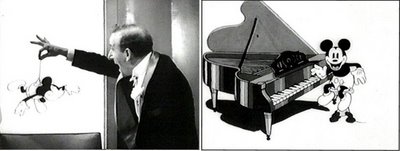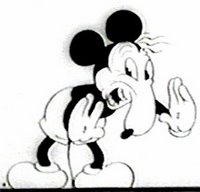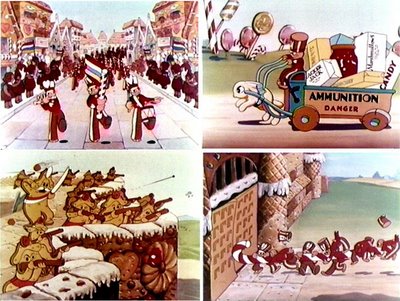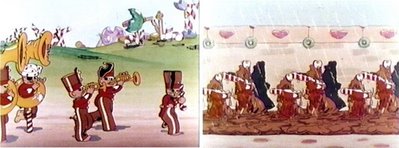You see, Mickey Mouse had star billing in an MGM movie. And he shared the credits with the likes of Jimmy Durante, Laurel and Hardy, and the Three Stooges.
 MGM commissioned Disney to create an animated sequence for its 1934 film Hollywood Party. Disney had animated short sequences for two Fox films in the same time period--a dream sequence in the 1934 film Servant’s Entrance, and a futuristic vignette in 1933’s My Lips Betray. What made Hollywood Party different was the use of then uber-star Mickey, and a cartoon story that was essentially a transplanted Silly Symphony. It was Disney entertainment, just not in a Disney Studio-produced movie.
MGM commissioned Disney to create an animated sequence for its 1934 film Hollywood Party. Disney had animated short sequences for two Fox films in the same time period--a dream sequence in the 1934 film Servant’s Entrance, and a futuristic vignette in 1933’s My Lips Betray. What made Hollywood Party different was the use of then uber-star Mickey, and a cartoon story that was essentially a transplanted Silly Symphony. It was Disney entertainment, just not in a Disney Studio-produced movie.As to the context of Disney producing material for other studios, author Michael Barrier noted in his book Hollywood Cartoons:
"In the early thirties, Disney ventured briefly into making animated inserts for two live-action features, Servants' Entrance and Hollywood Party, both released in 1934. He evidently saw such work as a way to ease into the making of his own features, but the inserts turned out to be more a source of irritation than of profit of any kind. Such sponsored films were inherently problematic, in Disney's scheme of things, because they were not under his control in the way that his shorts and features were. Once the feature inserts were behind him, Disney shunned most sponsored films."
Hollywood Party is a “revue” movie, a type that was popular during the 1930s. It was essentially a series of song and dance and comedy vignettes, strung together by a very, very loose, and at times non-existent plot. At the center is comedian Jimmy Durante who is hosting a lavish party with a star-studded guest list. While names like Jack Pearl, Polly Moran or June Clyde don’t ring many bells these days, the faces of Durante, Stan Laurel, Oliver Hardy, and Larry, Moe and Curly are still instantly recognizable.
 Mickey quickly takes center stage when party guests start screaming “A mouse! A mouse!”
Mickey quickly takes center stage when party guests start screaming “A mouse! A mouse!” Durante quickly comes to the rescue and suddenly finds himself at odds with the famous character, who is actually in “mouse scale” with the surrounding humans. Mickey is distinctly in his feisty, early 1930s personality, taking a swing at Durante and then mocking the star’s trademark oversized nose. He wins over the surrounding party guests who demand more entertainment from the little guy. Mickey then introduces a sequence very much akin to a Silly Symphony. The movie shifts from black and white to brilliant Technicolor to present The Hot Choc-Late Soldiers.
Durante quickly comes to the rescue and suddenly finds himself at odds with the famous character, who is actually in “mouse scale” with the surrounding humans. Mickey is distinctly in his feisty, early 1930s personality, taking a swing at Durante and then mocking the star’s trademark oversized nose. He wins over the surrounding party guests who demand more entertainment from the little guy. Mickey then introduces a sequence very much akin to a Silly Symphony. The movie shifts from black and white to brilliant Technicolor to present The Hot Choc-Late Soldiers. The Hot Choc-Late Soldiers is a bit bizarre in its story of candy-themed characters marching off and ultimately fighting a war. The action involves a Trojan War-themed combat with the Gingerbread Men of Pastryland. It is especially wacky when the injured soldiers return home, with battlefield injuries dressed in candy stylings (a missing leg is replaced with a candy cane stump for instance).
The Hot Choc-Late Soldiers is a bit bizarre in its story of candy-themed characters marching off and ultimately fighting a war. The action involves a Trojan War-themed combat with the Gingerbread Men of Pastryland. It is especially wacky when the injured soldiers return home, with battlefield injuries dressed in candy stylings (a missing leg is replaced with a candy cane stump for instance). It is not far removed from the studio’s own Silly Symphony Cookie Carnival produced in 1935. But while Cookie Carnival had the typical Disney happy ending, Soldiers ends on a note of humorous morbidity when the sun comes out and melts the celebrating victors.
It is not far removed from the studio’s own Silly Symphony Cookie Carnival produced in 1935. But while Cookie Carnival had the typical Disney happy ending, Soldiers ends on a note of humorous morbidity when the sun comes out and melts the celebrating victors.
Walt would quickly cease in producing material for other studios, and focus instead on his own plans for feature length films. And likely because the endeavors were owned by Fox and MGM, who had little interest in preserving Disney content, they have all but faded into obscurity. Hollywood Party had a brief VHS release in 1992.
 The sequence from Servant's Entrance miraculously surfaced last year courtesy of Didier Ghez, who writes the always informative and wonderful Disney History blog. Didier secured a copy and has generously made it available via YouTube and his site. The animation features kitchen utensils, led by a Humpty Dumpty-style egg character in a musical vignette that quite deftly for its time mixed live action and animation.
The sequence from Servant's Entrance miraculously surfaced last year courtesy of Didier Ghez, who writes the always informative and wonderful Disney History blog. Didier secured a copy and has generously made it available via YouTube and his site. The animation features kitchen utensils, led by a Humpty Dumpty-style egg character in a musical vignette that quite deftly for its time mixed live action and animation.According to the IMDB, only an incomplete print of My Lips Betray survives in the UCLA Film and Television Archives.



















1 comments:
Yeah, I saw Hollywood Party. The movie is terrible, like other revue films from that time, completely disjointed. It ends abruptly with out any real ending but then it never really had a story (Durante's Tarzan rip-off film bombs and he invites his friends over for a party to show off). Actors that are normally great and comedians that are normally funny are neither is this mess. It's all about getting as much names on the marque as possible. Mickey's appearance is the one saving grace and really the only reason to ever watch this movie. The white screen they draw him on is kind of distracting but the interaction between him and the live action is spot on (especially since they were inventing this stuff as they went along). Wasn't thrilled about the short that followed Mickey but it was nice to see color (which also shows how much higher quality Disney's product was than the actual movie it was placed in. The whole thing felt like one of those Depression B movies.
Post a Comment